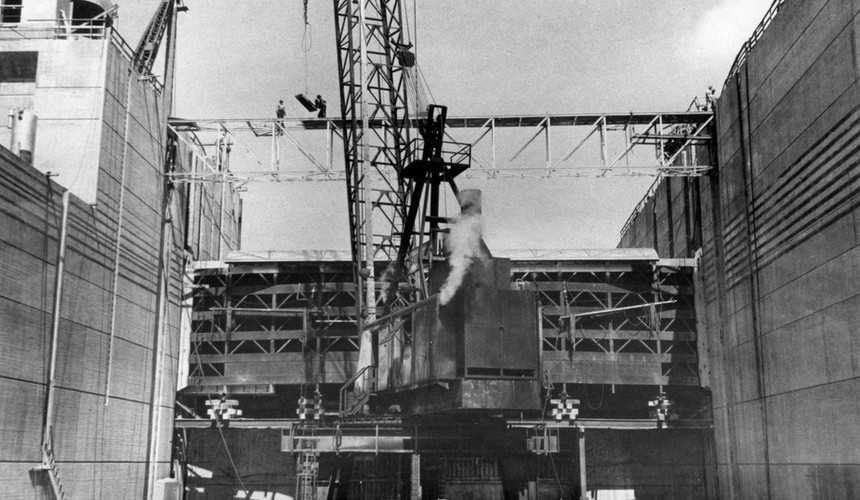Gateway To The Gulf: How the Chain of Rocks Canal made way for America's Central Port
- Alex Burkart
- Apr 1, 2019
- 3 min read
Updated: Apr 16, 2024
Maybe you've heard of Chain of Rocks Bridge, but did you know the reason it got its name is the same reason America's Central Port is able to transport $1.1 billion in freight annually?
Everyone knows the Arch is the Gateway to the West, but just north of St. Louis lies another gateway; the 8.4 mile man-made Chain of Rocks Canal, connecting Minneapolis to New Orleans and the Gulf of Mexico. Developed by the U.S. Army Corps of Engineers (USACE), without it, the Mississippi River would not be the strategic asset it is today, nor would America's Central Port be celebrating its 60th anniversary.

Fearing the Midwest would become an economic backwater, business interests of the 1920s pushed Congress to make the Mississippi River one of the most productive commercial waterways in North America.
The challenge?
Besides the already difficult nature involved in water engineering, the Upper Mississippi gradually drops in elevation of 420 feet over the course of 800 river miles. The first challenge was engineering a solution that would ensure a 9-foot deep channel for commercial traffic. In addition, from Minneapolis all the way to New Orleans, there is only one major impediment on the river, a 17 mile chain of rock ledges, located just north of St. Louis, hiding below the surface of the river.
In order to solve the drop in elevation challenge, the USACE placed 29 locks and dams along the river, 27 of which are still in operation.

Locks work as an elevator system for boats, raising or lowering the water level to meet the necessary elevation of the river. Of the 29 locks, some provide as high as a 49 foot lift to as little as 6 feet.
As for the 17 mile nightmare of rock ledges, in 1947 the USACE began construction on what would become known as the Chain of Rocks Canal and Lock and Dam #27, the last and most southerly lock and dam on the Mississippi.
“When the Chain of Rocks Canal and Lock 27 were originally constructed, it was one of the largest USACE projects. It has since been surpassed by other projects such as the Melvin Price Lock & Dam, Olmsted Lock and Dam, and New Orleans Hurricane and Storm Damage Risk Reduction System.”
- Brooke Magary, Public Affairs Specialist
U.S. Army Corps of Engineers
It was the completion of the Chain of Rocks Canal that led to the founding of America's Central Port.
During construction of the Canal, an opportunity to capitalize on the potential for the region was realized. Not only is Lock 27 the last lock on the river, providing free flowing navigation all the way to New Orleans, but when they constructed the Canal, the USACE dug out a 1 mile notch to be used for future barge fleeting and transloading needs.
Championed by Illinois State Representative Lloyd “Curly” Harris, and local attorney Randall E. Robertson, legislation was introduced and passed on April 1st, 1959, to transform this key access point into the Tri-City Regional Port District, marking the same date this year as the Port's 60th Anniversary.

Activities during these early years included managing the property and tenant leases, developing the land and adding infrastructure and new buildings, as well as working in coordination with other agencies on economic development initiatives for the region.
One of those agencies in particular was the Bi-State Development Agency. In 1956, prior to the passing of the Tri-City Port District Act, Bi-State finished construction on one of their very first projects, that of a 600-foot wharf in Granite City, IL. Located just North of Lock #27 on the one-mile notch of the Chain of Rocks Canal, Bi-State built a harbor that provided services such as mooring, loading and unloading barges, and the handling of commodities to be transported by barge and transit storage. In 1975, they sold their facilities to the Tri-City Port District, a move on the part of the Port that would allow them to leverage the full potential of the Chain of Rocks Canal and the Mississippi River.
Fast forward to present day. From the acquisition of a U.S. Army service and logistics center, to the construction of a $50 million inter-modal harbor and almost 30 miles of rail, to re-branding as America's Central Port, a lot has changed over the last 60 years. The mission however has remained the same. Since its inception, the Port has continued to play its role as a key economic driver, promoting advanced manufacturing, job growth, and enhanced transportation for the region.











































